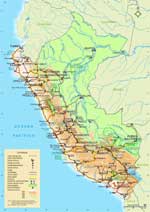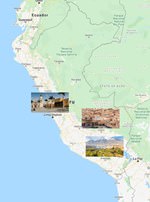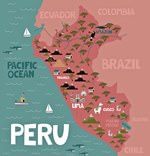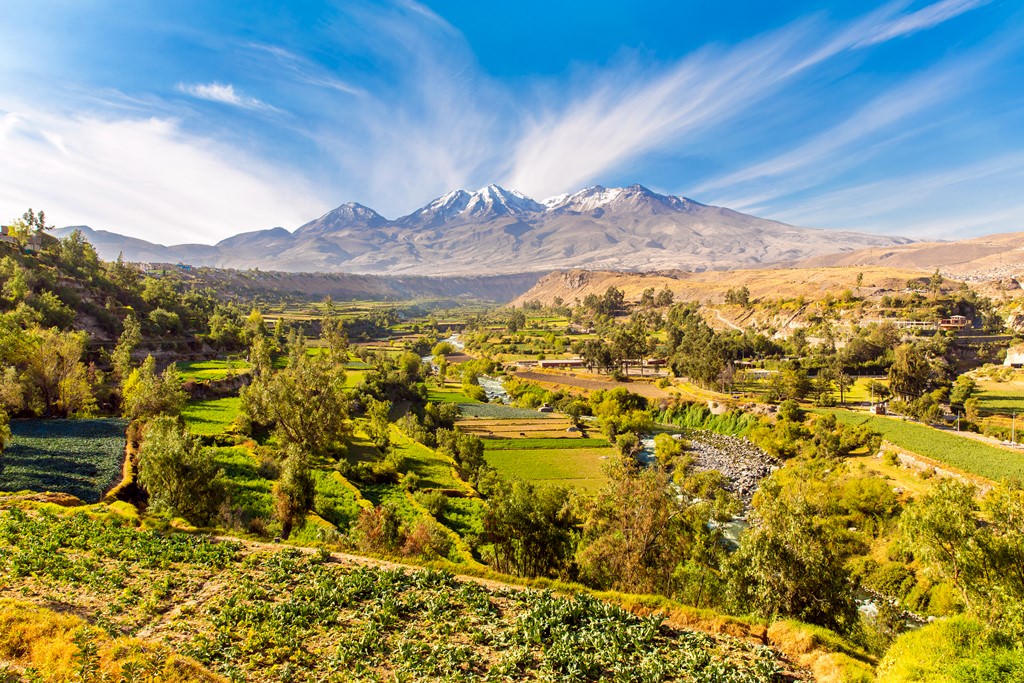Travel tips for Peru - what to prepare in advance and what to obey
 1. Peru is located in several climate zones. Therefore, the climate is very diverse here. Winter and summer are relative concepts. The costa stretches along the Pacific coast. These are desert, arid plains with very high humidity. The capital of the country Lima is located in this climate zone. It is hot and humid at any time of the year in the selva. The amount of precipitation is significant here. The climate is inhomogeneous in the mountains. Frosts are possible at high altitude even in the hottest time of the year. June, July and August are the best times to travel to the jungle (selva) and mountains. It is better to go to the coast in the period from December to March. Heavy rains fall in the forest and in the mountains in winter. March and April are most suitable for beach holidays.
1. Peru is located in several climate zones. Therefore, the climate is very diverse here. Winter and summer are relative concepts. The costa stretches along the Pacific coast. These are desert, arid plains with very high humidity. The capital of the country Lima is located in this climate zone. It is hot and humid at any time of the year in the selva. The amount of precipitation is significant here. The climate is inhomogeneous in the mountains. Frosts are possible at high altitude even in the hottest time of the year. June, July and August are the best times to travel to the jungle (selva) and mountains. It is better to go to the coast in the period from December to March. Heavy rains fall in the forest and in the mountains in winter. March and April are most suitable for beach holidays.
2. Some attractions, such as Machu Picchu, Huayna Picchu, Sacred Valley, Lima, and Cusco, attract a huge number of tourists in June and August. This makes the trip not very pleasant. Although it is traditionally considered that the summer months are the best for visiting these places, you can go here even in winter. The temperature is lower at this time. But the weather is still warm, mostly sunny. The rains quickly come to an end.
3. Visa is not required for travel to residents of most countries. But health insurance will come in handy. A travel agency can issue it if you purchase an organized tour. Independent travelers can do this in an insurance company or any travel agency. It is recommended to have vaccinations against yellow fever, hepatitis A, and typhoid. You need to bring your vaccination certificate with you. If you plan to visit the jungle, you should bring anti-malarial medications.
Peru is not the best place to shop. But there are many interesting handicrafts here. They are absolutely unique. Indigenous peoples have spent …
Read further
Read further
5. The locals do not like white sneakers and Hawaiian shirts for some reason. Therefore you should avoid these wardrobe items.
6. Public transport is well developed in large cities. There are buses there. They are quite dirty and crowded. There is also a combis (minibus). Travel in it is more expensive but more comfortable. There is a metro and rapid bus line in Lima. It is partially underground. It is better to agree on the price of a taxi ride in advance. You should use the official cars of yellow color. All types of transport, including aircraft, can be late. You should consider this when planning a transfer.
8. If you go to the mountains, you need to be ready for the symptoms of mountain sickness. Its symptoms (dizziness, nausea, shortness of breath, weakness) can appear at an altitude of 3500 meters above the sea. You need to drink as much as possible, at least 2-3 liters of water a day to relieve the condition. Locals resort to tea made from Coca leaves or simply chew the leaves. Tablets with Coca leaves have an even greater effect. They are sold in many local pharmacies. You also definitely need to bring bug repellent cream to protect from the sun's rays and a hat.
9. You should purchase a common ticket for Machu Picchu and Huayna Picchu in advance. There is a quota for the number of tourists per day. So you risk not getting to these attractions in the season. It is better to buy tickets 2-3 months in advance, for example. Tickets are sold on the official website of the Ministry of Culture of Peru. You can only pay with a Visa card. The same card must be presented at the entrance to Machu Picchu.
10. In general, Peru is considered a fairly safe country for tourists. However, you should not leave your things unattended and carry large amounts of cash. It is better to exchange money in banks. You should leave your documents in the hotel safe and make a copy for yourself. It is better to choose a hotel in the Miraflores district of Lima. You should not walk in the historical center at night.
11. Sol is the official currency. But you can pay with US dollars in many places. It is unprofitable and inconvenient to take euros with you. You can pay with cards almost everywhere in the cities. However, you will need cash in the province. Some banks set a limit on cash withdrawals. Therefore, you should take a few cards with you.
Monuments and architectural objects, notable for the history and culture of the country.
…
Read further
Read further
13. Peru is a very poor country. Talking about money is not considered shameful here. Locals can ask tourists how much they earn at home or how much their hotel costs. You should not take such questions as insults or tactlessness.
14. It is better to take a jacket even in the hottest time of the year. It is sharply colder in some areas, especially high-altitude, after sunset.
15. Beach holidays are not very popular in Peru. But you can bask on the beaches of the north of the country between October and March. 
This collection of travel tips for Peru is protected by the copyright law. You can re-use the content, but only under the condition of placement of an active link to www.orangesmile.com.
Fantastic City Tours and Excursions in Peru
Colorful and unique places in Peru
Machu Picchu
From the series “15 Unofficial Man-Made Wonders of the World” One of the amazing wonders of the world that managed to survive to the present day is in Peru. That's the famous ancient citadel of Machu Picchu located in a picturesque mountainous area at an altitude of 2 450 meters above sea level. It was called the New Wonder of the World in 2007. Many amazing legends and mysteries tell about the city in the sky. By the way, until now researchers hesitate about the date of foundation.
One of the amazing wonders of the world that managed to survive to the present day is in Peru. That's the famous ancient citadel of Machu Picchu located in a picturesque mountainous area at an altitude of 2 450 meters above sea level. It was called the New Wonder of the World in 2007. Many amazing legends and mysteries tell about the city in the sky. By the way, until now researchers hesitate about the date of foundation. However, the main mystery of Machu Picchu relates to the events of 1532, when a large and prosperous city suddenly went deserted. What made local residents to leave their homes and where they disappeared? Scientists are trying in vain to find it out for more than a hundred years. About 200 structures, including religious buildings, residences, warehouses and other … Read all
Lagunas Norte
From the series “Famous Spots of Gold Mines Reminding the Gold-Rush Times” The Lagunas Norte Mine, located in Peru, is also a significant asset to the Barrick Gold company, which brings the company more than 800000 ounces of gold each year. The deposit is located in a mountainous area, at an altitude of 4000 to 4260 meters above sea level. It is noteworthy, that for the Barrick Gold company the development of one of the world's richest gold deposits turned out to be one of the cheapest in the history of the company's work.
The Lagunas Norte Mine, located in Peru, is also a significant asset to the Barrick Gold company, which brings the company more than 800000 ounces of gold each year. The deposit is located in a mountainous area, at an altitude of 4000 to 4260 meters above sea level. It is noteworthy, that for the Barrick Gold company the development of one of the world's richest gold deposits turned out to be one of the cheapest in the history of the company's work.The first gold deposits in the territory of the current industrial region were discovered in 2002. Three years later the mine was completely finished. The extraction of gold at the deposit is conducted in an open way. About 2000 people are constantly employed in industrial work. According to rough estimates for the end of 2014, the deposit's … Read all
Yanacocha Mine
From the series “Famous Spots of Gold Mines Reminding the Gold-Rush Times” Peru is also famous for its variety of gold mines, the most famous of which is the Yanacocha mine. It is located in the northern part of the state and is the largest gold deposit in Latin America, with annual production of about 1460000 ounces. The owner of the mine is the Newmont Mining company. There is a valuable deposit in the highlands of the Andes, its development began in 1993.
Peru is also famous for its variety of gold mines, the most famous of which is the Yanacocha mine. It is located in the northern part of the state and is the largest gold deposit in Latin America, with annual production of about 1460000 ounces. The owner of the mine is the Newmont Mining company. There is a valuable deposit in the highlands of the Andes, its development began in 1993.Currently, precious metal is mined in three open quarries, and the total area of the industrial district is 10 x 4 km. According to rough estimates, the investments in the development of the gold mine amounted to about 150 million US dollars. Since the opening of the mine, its development has caused a lot of controversy among local residents and activists.
In the opinion of the indigenous population, the … Read all
Hilton builds third luxury hotel in Kyoto
It will welcome its first guests in 2024. 313 rooms of various categories will be available, the interior of rooms and hotel spaces will become one of the main features of the high-class hotel. When decorating the rooms, it is planned to use local textiles, which are famous for their high quality and are considered to be one of the best in the world. Read this
Read this
24.04.2024
It will welcome its first guests in 2024. 313 rooms of various categories will be available, the interior of rooms and hotel spaces will become one of the main features of the high-class hotel. When decorating the rooms, it is planned to use local textiles, which are famous for their high quality and are considered to be one of the best in the world.
24.04.2024
Photogallery of sightseeing Peru
Advices for popular cities of Peru
1. In large hotels mains voltage is 220 V. However, in small hotels located away from the center private generators may be used; in this case, the voltage is 110 V. All details have to be clarified prior to check in. If necessary, take special adapters and connectors for electrical devices with you. 2. Calls to other cities and countries are better to be made from public call offices. Phone cards, which can be used when calling from pay phones, are widespread. It is worth noting that calls … Read more 


 English
English Russian
Russian Nederlands
Nederlands Deutsch
Deutsch Español
Español Français
Français Türkçe
Türkçe





















